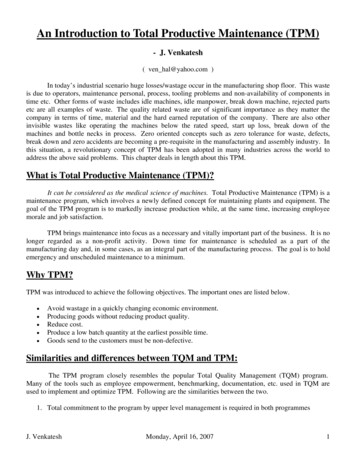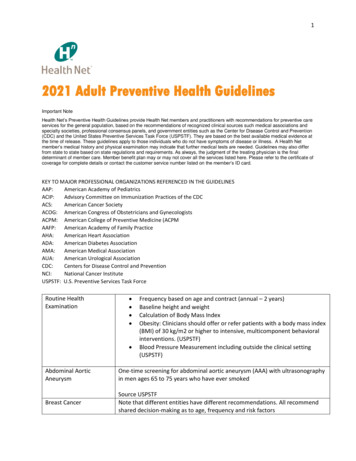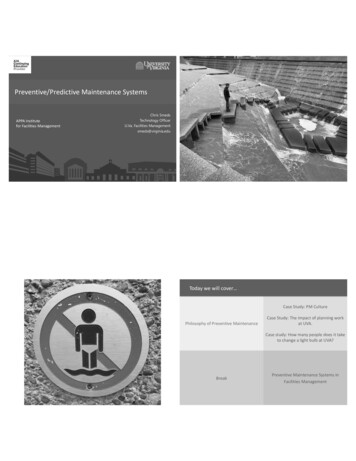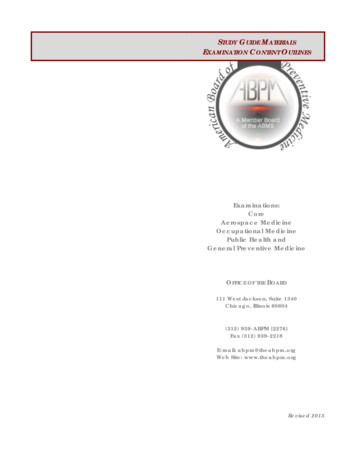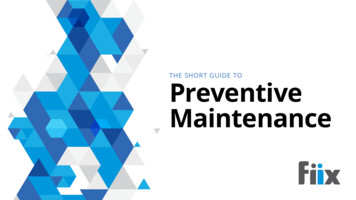
Transcription
THE SHORT GUIDE TOPreventiveMaintenance
Table of ContentsCHAPTER 01What is preventive maintenance and why do I need it?3CHAPTER 02How to stop reacting and start preventing8CHAPTER 03Preventive maintenance technology10CHAPTER 04How a CMMS paves the way to preventive maintenance13CHAPTER 05Finding, evaluating and buying your preventive maintenance system16Conclusion24Learn more/Get in touch252
C H A P T ER 01INTRODUCTION:What is preventivemaintenance andwhy do I need it?3
CH 01: What is preventive maintenance and why do I need it?Let’s start with a question:How many hours a day do you spend onunplanned maintenance?If the answer is “too much!” you’re not alone. So many organizations— from mom and pop shops,to large multinationals, to our global infrastructure— are suffering from too much unplanned (andnot enough proactive) maintenance.“Maintaining physical assetsis not always the top priorityas compared to various otherfunctions.”“Officials in federal, state andlocal government do not allocatethe resources necessary forpreventive maintenance.”MarketsandMarkets Enterprise AssetManagement Market Global Forecast to2021The Maintainers Let’s Get ExcitedAbout Maintenance“Since 1998, America’s infrastructurehas earned persistent D averages, andthe failure to close the investmentgap with needed maintenance andimprovements has continued.”ASCE 2017 Infrastructure Report Card4
CH 01: What is preventive maintenance and why do I need it?Unplanned maintenance:Why is it a problem?It costs moreUnplanned maintenance can cost you big time — up to three to nine times more thanplanned maintenance. These costs can come from lost production as your team hurriesto get things back up and running, higher costs for parts and rush shipping, or lost timeresponding to emergencies and diagnosing faults.It’s inefficientUnplanned repairs take longer, suck up resources, and interfere with existing plannedwork, because too much time spent diagnosing the problem and determining whatshould be done to fix it. Furthermore, if a problem is not repaired correctly, the issuecould re-occur and cause even more downtime.It’s unsafeWhen unplanned maintenance is needed, technicians are often under pressure to getthings up and running quickly. This can cause workers to take risks they wouldn’t takeif the work was scheduled with enough time to review the standard operating procedures and safety requirements to complete the job effectively.5
CH 01: What is preventive maintenance and why do I need it?PLANNED MAINTENANCE TYPESThe alternative: Planned,proactive maintenancePlanned maintenance:a definitionPlanned maintenance is an umbrella term that refers to anymaintenance activity that is documented, scheduled and carried out.It may seem counterintuitive, but planned maintenance can includescheduled maintenance types like preventive, total productivemaintenance, and predictive maintenance as well as unscheduledmaintenance like run-to-failure.The difference between planned, unscheduled maintenance anddetrimental unplanned maintenance is that in a planned, proactivemaintenance approach only certain assets—likely low-cost ones thataren’t essential to production— will be allowed to run to failure. Agood example of this is planning to replace a light bulb whenever itstops working, instead of proactively replacing it.PreventiveAs the name suggests, preventive maintenance is maintenance that is regularly performed on a piece of equipment to prevent asset failure and unexpected downtime.It is performed while the equipment is still working (rather than after it’s brokendown). Preventive maintenance is planned on a time, meter, or usage-based trigger.TPMTotal productive maintenance (TPM) is the idea that everyone in a facility shouldparticipate in maintenance. This approach uses the skills of all employees and seeksto incorporate maintenance into the everyday performance of a facility. Employingan effective TPM approach results in fewer breakdowns, a safer work environment,and better overall performance.PredictiveThe aim of predictive maintenance (PdM) is to predict when equipment failuremight occur and prevent the failure by performing maintenance. Ideally, predictivemaintenance allows the maintenance frequency to be as low as possible to preventunplanned reactive maintenance, without incurring costs associated with doing toomuch preventive maintenance.ReactiveYes, reactive and run-to-failure maintenance can be part of a healthy plannedmaintenance approach. In this strategy, assets are deliberately allowed to operateuntil they break down, at which point reactive maintenance is performed. Having aplan in place ahead of the failure means the asset can be fixed without causing anyproduction issues.6
CH 01: What is preventive maintenance and why do I need it?The starting point: preventive maintenanceWhether your ultimate goal is TPM or even predictive maintenance, the foundation of any solid planned maintenance program is preventive maintenance.Advantages of preventive maintenanceIn 2017, Plant Engineering conducted a survey to understand maintenance practices across North American manufacturing facilities. 69% of survey respondents said thatpreventive maintenance helps them decrease downtime, 66% cited reduced probability of failure, 63% saw better OEE, and 62% experienced an improvement in safety.80%70%60%Decrease equipment downtimeReduce probability of failure, and extend theoperational lifetime of assets and infrastructure50%40%30%Improve overall equipment effectivenessImprove occupational health and safety20%10%0%7
C H A P T ER 02How to stopreacting andstart preventing8
CH 02: How to stop reacting and start preventingHow do you make the shift?You’ve already taken the first steps towards preventive maintenance by downloadingthis guide.It’s important to understand that these changes don’t happen overnight. However, thereare solutions that can help you carry out the necessary planning, scheduling, and trackingto pull off a preventive maintenance program successfully.WHY ADOPTMAINTENANCESOFTWARE?Longer asset lifeThis is where preventive maintenance technology comes inBy investing in technology like maintenance software, organizations can move away fromcostly reactive maintenance and start tracking, maintaining, and managing their assets ina way that will increase their useful life and provide benefits across the organization.Reduced maintenanceand procurement costsBetter asset trackingImproved returnon assets9
C H A P T ER 0 3Preventivemaintenancetechnology10
CH 03: Preventive maintenance technologyThe great debate: CMMS vs EAMfor preventive maintenanceThere are a number of great solutions available to help you manage maintenance at your facility, but thetwo that you’ll hear about the most are enterprise asset management (EAM) software and computerizedmaintenance management systems (CMMS).ASSETLIFECYCLESo what’s the difference between CMMS and EAM, and how do you choose between them?CMMS software helps maintenance teams easily keep a centralized record of all assets and equipment they areresponsible for, as well as schedule and track maintenance activities and keep a detailed record of the workthey’ve performed. Generally speaking, the purpose of a CMMS is to manage all maintenance activities duringthe operational part of an asset’s life—all the time that it’s working as a productive part of a facility.In contrast with a CMMS, EAM software provides a view of an organization’s assets and infrastructurethroughout the entire life cycle, from creation or procurement through to disposal.EAMCMMSFocus on the best fit for your maintenance teamMaintenance software can be a game changer when it comes to establishing a preventive maintenance program, but keep in mind that a system isonly valuable if people use it. So while the rich feature sets of EAM software might be tempting, it’s important to choose a solution that fits your team.EAM might be the top choice for the IT and finance team, but a CMMS is made for maintenance teams. Most modern CMMS solutions include simple,easy-to-use interfaces with intuitive work order creation, calendars and reporting that focus on decreasing the number of keystrokes between themaintenance team and the job at hand, and increasing the utilization of the system.11
CH 03: Preventive maintenance technologyCMMS: Your key tomodern maintenanceCapture and access historical asset dataThe foundation of aworld class maintenanceorganization is a CMMS.You have to havesomething to captureinformation and steeryour efforts in the rightway. It’s a necessity.Manage inventory with parts and supplies trackingTony LeombrunoTPM Champion at Ardagh GroupCMMS: A definitionA CMMS is software that helps teams keep a record of all assets they are responsible for, scheduleand track maintenance tasks, and keep a historical record of work they perform.A CMMS solution can help you:Manage work ordersSchedule and automate preventive maintenance tasksEnable technicians in the field with a mobile appRun reports for your most important KPIs12
C H A P T ER 0 4How a CMMSpaves the wayto preventivemaintenance13
CH 04: How a CMMS paves the way to preventive maintenanceBenefits of a CMMSWe’ve estimated costsavings of about 10-15%by just removing tasksbecause we found we didn’treally need to do them.According to the 2017 Plant EngineeringMaintenance Report, respondents said that betteroverall efficiency, improved OEE and decreaseddowntime were the biggest benefits of a CMMS.Improves overallefficiencyBoosts overallequipmenteffectivenessTony LeombrunoTPM Champion at Ardagh GroupDecreasesdowntime14
CH 04: How a CMMS paves the way to preventive maintenanceBenefits of a CMMSEffectively plan your PMsA CMMS ensures planned preventive maintenance is triggered when it’s due. Once the system is configured, work orders are pushed totechnicians based on the triggers you’ve set up.Standardize best practicesHaving one central system (instead of a combo of paper work orders, Excel and work boards) means everyone uses the sameprocedures and follows the same best practices.Access real-time informationAccess important information like procedures, error logs, manuals, permits, licences, photos, images, diagrams, and schematics withinasset records. This speeds up troubleshooting and work order processing times.Quickly access asset historyWithout a CMMS, a good portion of an asset’s history is stored in the memory of a technician. A CMMS allows each asset to have its ownunique record that details its maintenance schedule, repairs completed, parts used, and more, which can be accessed quickly and easily.Effortlessly track maintenance-related costsBecause a CMMS tracks parts, labour, service history and other miscellaneous expenses, it’s easy to run costing reports to see wherebudget was spent and make educated decisions about whether a piece of equipment should be repaired or replaced.Quickly access detailed maintenance metrics and reportsData available on your dashboard and in reports generated allows you to analyze asset failures, downtime, resource utilization, andspending patterns in the CMMS. This gives you greater visibility and the ability to implement changes to add value or reduce risk.Get control over inventoryAutomatically track parts, manage suppliers and vendors, optimize inventory levels and make sure you always have the right part onhand when it’s needed.15
C H A P T ER 0 5Finding, evaluatingand buyingyour preventivemaintenance system16
CH 05: Finding, evaluating and buying your preventive maintenance systemIn order to use your CMMS to manage preventive maintenance, you have to make sure all stakeholders in yourorganization are on board from the get-go.Following these four steps can help you lay the groundwork to successfully modernize your maintenanceoperations and get a preventive maintenance program off the ground.1Define theproblem you’retrying to solve2Gatherstakeholders3Get userbuy-in4Evaluate softwaresolutions17
CH 05: Finding, evaluating and buying your preventive maintenance systemDefine the problemUnplanned downtime, too much reactive maintenance and maintenance backlogare all symptoms of larger issues. Some of the challenges that Fiix customershave encountered before implementing a CMMS include:Different systems across different sitesNo cohesive maintenance planNo system to gather and provide easy access to dataTime wasted writing notes for the next shiftNo defined KPIsEvery business has different challenges. It’s essential to have a fullunderstanding of the problems you’re trying to solve before buying software,so everyone is on the same page once the system is implemented.18
CH 05: Finding, evaluating and buying your preventive maintenance systemGather stakeholdersWho will be involved in using the CMMS?Though it is often management and executive teams who make the decision to implementmaintenance software, it’s important to think about each person who will interact with thesoftware. On top of admins, maintenance managers, and technicians, consider including thefollowing roles as stakeholders in your CMMS implementation:OperatorsReliability engineersTool crib operators and inventory managersHealth and safetyExtending the system to these roles will let everyone see the information stored in yourmaintenance management software and log information of their own, bringing you one stepcloser to a holistic approach to maintenance.19
CH 05: Finding, evaluating and buying your preventive maintenance systemGet user buy-inWhile the benefits of maintenance management software are clear, some organizationsstill experience resistance when bringing in new systems. Since a CMMS is only as goodas the data going into the system, it’s essential that you get buy-in from every user, andensure everyone feels confident in using the system.For this reason, it’s important to consider vendors that offer robust training and support.Maintenance managers should never have to feel like it’s up to them to train users andfigure out how the system works. The asset management software industry is full ofexperts who can pass along best practices and standard operating procedures.Top questions to ask to make sure you’regetting buy-in for your new system:Read more about setting yourCMMS implementation upfor successCreating a work culture to setyour CMMS implementation upfor successWhat is reliability culture? Is your culture set up to support a CMMS? Is your workforce open to changes in process? Do you have guiding principles in place that will make it easier to support theimplementation of a CMMS?3 steps to a successful CMMSimplementation Can you answer the question, “What’s in it for me?” for every system user?20
CH 05: Finding, evaluating and buying your preventive maintenance systemEvaluate solutionsNow that everyone is on board with the new system and ready to ditch unplannedreactive maintenance for good, it’s time to actually evaluate solutions.Here are 7 big questions to ask when buyingmaintenance software:Is it the right solution for your business size?It’s important to evaluate what your needs are and ensure the CMMS options you areconsidering will be able to accommodate those needs. Cloud-based CMMS softwarehas the benefit of quickly adding and removing users and sites, so that it can adjust tovirtually any team size.Is it easy to use?A CMMS can have all the features you could ever need, but if it’s not intuitive for yourmaintenance staff, it’s useless. It’s very important to consider how easy software is touse, configure, and implement before you invest.Does the vendor offer training and support?Adopting new software requires support. Make sure your provider offers training tohelp get set up, in addition to good post-implementation support. Resources like helpcentres and on-premises training are also essential.What is included in the price?There are a number of factors to consider when looking at the cost ofa CMMS over its lifetime, including the subscription cost, the cost ofimporting data and integrating it with other business systems, the costof upgrades, and the cost of training and support.Is it mobile?It’s important to find a CMMS that allows you to be fully mobile, withfeatures like offline mode, QR and barcode scanning, and an easy-to-useinterface.What features do you really need?Which features are you willing—and not willing—to compromise on?CMMS software comes with many different features, so it’s importantfor you to decide which ones are essential for your organization, so youcan rank your options based on how well each of them meet your “musthave” criteria.What integrations are available?Will you need to integrate with other systems? If so, are they compatiblewith the CMMS options available? Many CMMS options offer integrationswith ERP software and other enterprise-level solutions. Ask yourselfwhich integrations you will require, and if you’ll be able to make it workwith the options available to you.21
CH 05: Finding, evaluating and buying your preventive maintenance systemDownload our CMMSfeature scoring calculatorWe built a tool to help you evaluate thevendors and features available to youas you hunt for the right maintenancesoftware for your business.Download it here and get yourevaluation started!22
CH 05: Finding, evaluating and buying your preventive maintenance systemHow did they do it?Ardagh Group’s CMMS journeyArdagh Group is a global leader in glass and metal packaging solutions. The company operates 109 glass and metal manufacturing facilities in 22 countries, creating packagingfor sectors including beverage cans, food, aerosols, beer and spirits. Tony Leombruno is their TPM Champion and recently introduced a CMMS in seven facilities.According to Tony, before getting a CMMS “there was no uniformity of work practices. Everyone was just doing their own thing, the best way that they could.” Since implementinga CMMS, Tony and his team have unified maintenance activities across seven facilities, and have estimated cost savings of 10-15% thanks to PM optimization.“Before, the guys on the floor were thinking, ‘I hope I get everything done. I’m not even sure exactly what needs to be done.’ Versus now, especially with the new dashboardfeatures, it’s more like, ‘I know specifically what I need to do, when I need to get it done by, and in addition to that, I can track my performance.”Read the full case study here.STEPS TO IMPLEMENT A CMMS AT ARDAGH GROUP:1Assembledsteering team2Evaluated softwareoptions by ratingfeatures from 1-1053Rolled out software atthree pilot plants4Established KPIs andbegan optimizing PMsExtended rollout toremaining plants23
ConclusionYou’ve got this!Maintenance is a complex job—there’s no magic bullet for makingthings run smoothly. But defining the problem you’re trying to solveand sourcing technology to help you establish a PM schedule, organizeyour team and tasks, and track KPIs are solid first steps on your path topreventive maintenance.24
Learn moreVisit www.fiixsoftware.com for moremaintenance reading and resources.You can also visit our case studies to seehow others like you have streamlinedtheir maintenance operations witha CMMS www.fiixsoftware.com/resources/case-studies.Want to chat?Get in touch with Fiix.35 Golden Ave Suite A-201Toronto, ON, CanadaM6R 2J5Local: 1 (647) 317-9055Toll Free: 1 (855) 884-5619info@fiixsoftware.com25
for preventive maintenance EAM CMMS ASSET LIFECYCLE CH 03: Preventive maintenance technology Focus on the best fit for your maintenance team Maintenance software can be a game changer when it comes to establishing a preventive maintenance program, but keep in mind that a system is only valuable if people use it.



